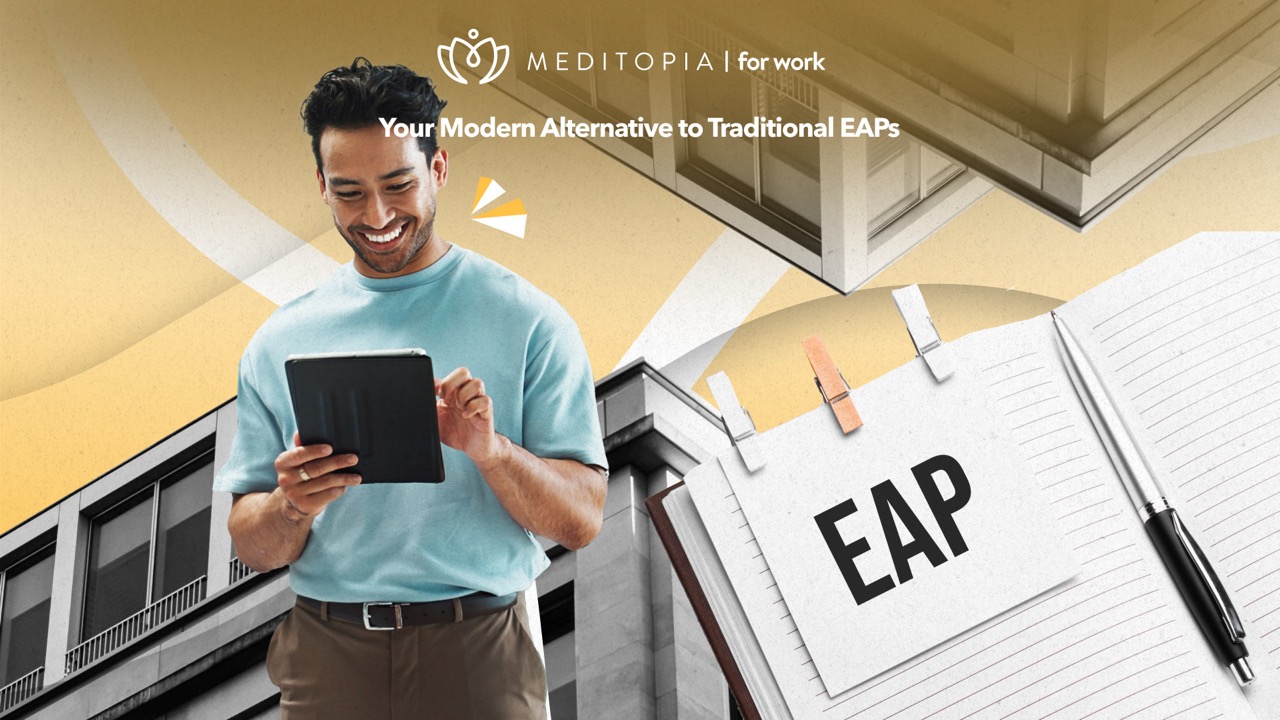Employee Assistance Programs (EAPs) have emerged as a vital resource, offering support services that address personal and work-related challenges. However, despite their availability, EAP utilization remains low, with average usage rates below 10% [1] due to bad communication plans and the lack of internal promotion. Keep reading to discover what is EAP coverage and how it can help your company thrive.
What Support Can an EAP Offer Employees?
Understanding what support an employee assistance provider can offer is crucial for HR professionals and managers aiming to enhance workplace productivity and morale.
Now, a well-structured Employee Assistance Program (EAP) is not an EAP that provides a hundred services. A well-structured EAP is one that has enough services and resources that your organization can utilize for its specific needs. Here’s a list of ways an EAP can support an organization:
- Mental Health Support: One of the most critical aspects of EAP coverage is providing confidential counseling for stress, anxiety, depression, and substance abuse. Employees can access short-term counseling and, if necessary, referrals to long-term care. Studies [2] show that workplaces with strong mental health resources see improved retention rates and higher engagement.
- Workplace Stress Management: Work-related stress can significantly impact employee well-being and performance. EAPs provide coaching, workshops, and self-help resources to help employees manage pressure effectively. These programs often include resilience training and mindfulness techniques to reduce burnout.
- Legal and Financial Guidance: Many EAPs offer financial and legal support, helping employees with estate planning, credit counseling, debt management, and even legal consultations. This aspect of EAP coverage ensures employees have access to expert guidance without additional financial burdens, and helps them to understand and manage financial anxiety, and develop financial wellness.
- Dependent Care Services: Employees balancing caregiving responsibilities can access EAP coverage for child care and elder care resources. This support helps employees maintain a healthy work-life balance, ultimately benefiting workplace morale.
- Workplace Conflict Resolution: An overlooked but vital function of what an employee assistance provider can offer is mediation support to resolve workplace conflicts. Dispute resolution coaching can help teams improve communication and collaboration.
Some other benefits EAPs may include are: online therapy, personalized corporate workshops and trainings (for managers and employees), crisis intervention, veterinarians, nutritionists, personal trainers, etc. And Meditopia for Work offers them all through a pick-your-service plan. Send us a message to discover more!
Who Is Eligible for EAP Coverage?
A common question among HR leaders is what is EAP coverage and who qualifies for it. Most EAP coverage extends to all full-time employees, while some organizations also provide benefits to part-time staff and contractors.
- Full-time employees: Typically, all employees with benefits eligibility can access EAP resources, including counseling, work-life services, and legal or financial assistance.
- Family members & dependents: Many EAPs extend employee assistance provider support to immediate family members, including spouses and dependent children. Some programs even offer support for non-traditional family structures, such as live-in partners or caregivers.
- Retirees & former employees: In some cases, EAP coverage may be available for a set period post-employment, especially for employees transitioning out of the workforce due to retirement or layoffs.
It is important to mention that while federal laws influence certain operational aspects of EAPs, they do not prescribe specific eligibility requirements.
Employers have the discretion to define who is eligible for their EAP offerings, which often include full-time employees and may extend to part-time staff and immediate family members, depending on the organization's policies.
To learn more about mental health laws, please check our blog on the matter.
What Does an Employee Assistance Program (EAP) Cover?
So, now you know what is an EAP, but what exactly can EAPs cover? Understanding what EAP programs offer can help HR professionals and managers effectively utilize these resources to enhance employee well-being and organizational productivity.
Let’s check some of the most important coverages EAPs can offer your company:

1. Counseling Services
A cornerstone of EAPs is providing confidential counseling to address a variety of challenges at work. Like stress management, burnout, lack of motivation, procrastination, etc. But also, heavy challenges related to employee mental health, such as anxiety, depression, and substance abuse.
These services typically include:
- Assessments
- Short-term counseling (online and on-site)
- Referrals to specialized professionals when necessary
- Therapy support through physical trainers and mindfulness practices
For instance, the U.S. Office of Personnel Management [3] notes that EAPs offer free and confidential assessments and short-term counseling for employees dealing with personal or work-related problems.

2. Workplace Stress Management
Approximately 83% of U.S. workers experience work-related stress, with 54% reporting that stress from work affects their personal lives [4].
It is true that EAPs can’t offer a magical solution to both types of stress, but they equip employees with strategies to manage work-related stress effectively through workshops, stress management techniques, and one-on-one coaching sessions.
This is what we know as empowerment. HRs, leaders, and managers, even EAPs, can’t fix directly the root of stress in employees, but they can offer mental health resources employees can reach at will when needed the most.
3. Legal and Financial Guidance
91% of HR leaders report that they suspect employees are facing financial hardships, and 46% of employees agree, indicating a significant need for workplace financial support [5].
That's why many EAPs provide access to legal and financial advisors who can assist with issues like estate planning, housing matters, budgeting, and retirement planning.
Again, these services aim to alleviate personal burdens that can affect workplace focus and productivity. They may not change the employees’ economic situation, but they do offer clarity and guidance that can significantly enhance their mental health and reduce the consequences of constantly overthinking about legal or economic matters.
4. Dependent Care Services
As of 2023, only 12% of all U.S. workers had access to employer-provided childcare benefits, a figure that drops to 6% for part-time employees or those in the lowest income quartile [6].
Being a caregiver can also increase feelings of stress, guilt, and anxiety. Whether your employees must take care of a child, elder, or loved one with a physical or mental condition, this will affect the employees’ productivity, performance, and even attention.
EAPs often extend support to employees managing caregiving responsibilities by offering resources related to child care and elder care. This assistance helps employees balance their work and personal lives more effectively.
5. Workplace Conflict Resolution
Workplace disputes and personality clashes take up approximately 2.8 hours per employee per week, costing employers an estimated $359 billion annually in lost productivity [7].
To foster a harmonious work environment, EAPs may offer services aimed at resolving workplace conflicts. This includes mediation sessions and communication workshops to improve professional relationships.
The U.S. Office of Personnel Management also states that workplace conflict resolution services provide assistance in navigating workplace tensions and improving communication methods. Making them an ideal feature of EAPs.
To learn more about employee conflicts or how to talk about changes at work, please read our blogs on the matter.
6. Health and Wellness Programs
Health and wellness programs have been shown to decrease absenteeism and presenteeism. For instance, companies implementing wellness initiatives have observed a 25% increase in productivity [8], as these programs help reduce presenteeism and improve employee loyalty and happiness.
These programs can include:
- Support for managing chronic health conditions
- Nutritional counseling
- Fitness and meditation programs
- Online therapy
- On-demand personalized workshops and webinars
A key factor when choosing an EAP for their health and wellness programs is their holistic approach. As human beings, mind and body are interconnected and can influence each other equally. Therefore, an EAP coverage that mixes both types of support is ideal.
7. Career and Skill Development Resources
While primarily focused on personal well-being, some EAPs also offer resources to support career growth and skill development. This can include coaching sessions to improve job performance, workshops on time management, and strategies for career advancement.
Employees are more likely to remain with organizations that invest in their professional growth. Notably, 94% of companies express concern about their retention rates [9], and opportunities for training and development are key factors influencing employees' decisions to stay.
What Services Aren’t Covered by an EAP?
While Employee Assistance Programs (EAPs) offer a range of supportive services, it's essential to understand their limitations to manage expectations effectively.
Services Typically Not Covered by EAPs:
- Medical Treatments and Prescriptions: EAPs are designed to provide short-term counseling and referrals but do not cover medical treatments or prescribe medications. Employees requiring medical interventions or long-term therapy are usually directed to healthcare providers or specialists.
- Long-Term Therapy: EAPs focus on brief counseling interventions, often limited to a set number of sessions. For instance, many programs offer up to eight sessions per issue. Individuals needing extended mental health support are referred to external professionals for ongoing care.
- Non-Work-Related Legal Services: While EAPs may provide basic legal consultations, they typically do not cover extensive legal representation, especially for issues unrelated to employment. Employees requiring in-depth legal assistance are advised to seek external legal counsel.
- Financial Assistance: EAPs can offer financial counseling and resources to help manage personal finances but do not provide direct financial aid or loans. Employees facing significant financial challenges may need to explore external financial institutions or assistance programs.
- Specialized Medical Care: Services such as dental care, vision care, and other specialized medical treatments are beyond the scope of EAP coverage. Employees are encouraged to utilize their health insurance benefits or seek appropriate medical professionals for these needs.
To discover more about EAPs for small businesses and how to support your team with a small budget, please visit our blog on the matter.
























